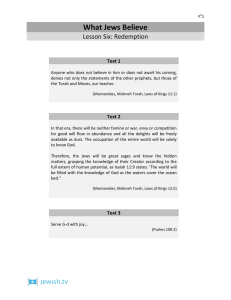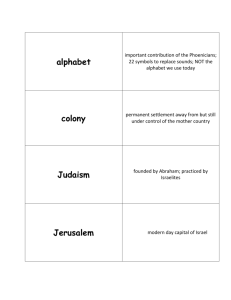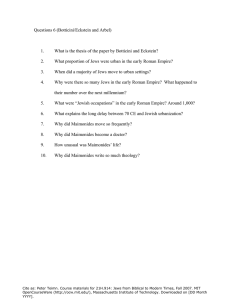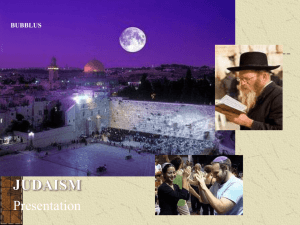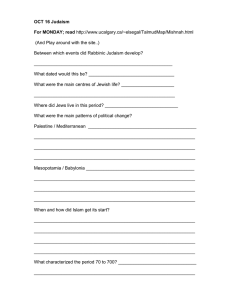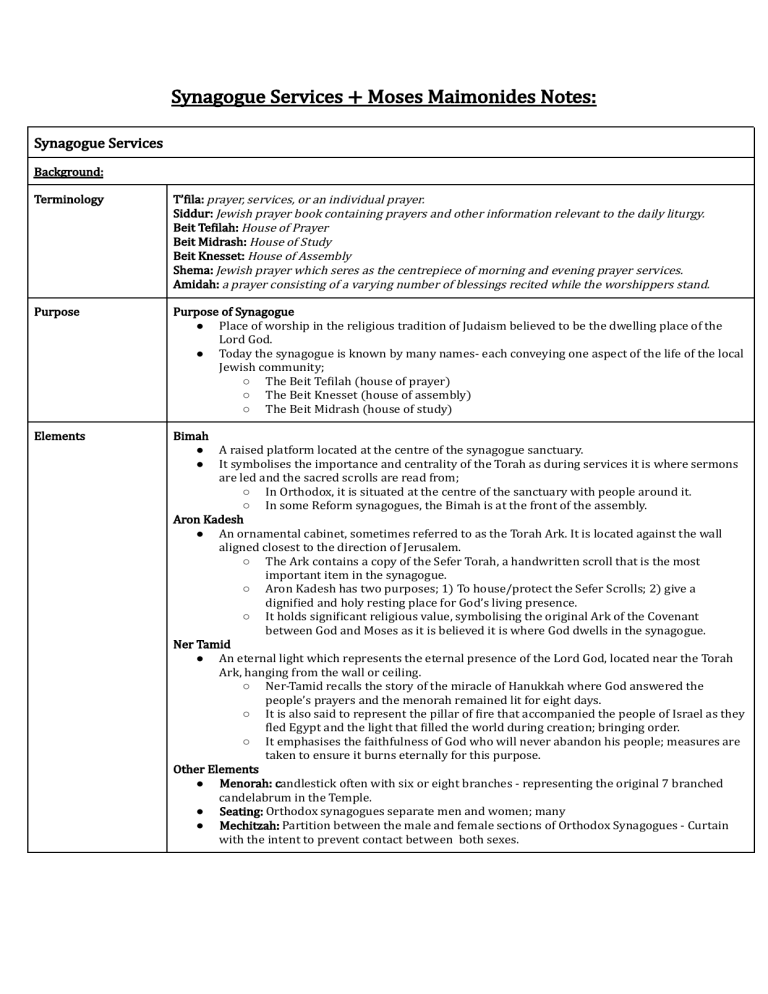
Synagogue Services + Moses Maimonides Notes: Synagogue Services Background: Terminology T’fila: prayer, services, or an individual prayer. Siddur: Jewish prayer book containing prayers and other information relevant to the daily liturgy. Beit Tefilah: House of Prayer Beit Midrash: House of Study Beit Knesset: House of Assembly Shema: Jewish prayer which seres as the centrepiece of morning and evening prayer services. Amidah: a prayer consisting of a varying number of blessings recited while the worshippers stand. Purpose Purpose of Synagogue ● Place of worship in the religious tradition of Judaism believed to be the dwelling place of the Lord God. ● Today the synagogue is known by many names- each conveying one aspect of the life of the local Jewish community; ○ The Beit Tefilah (house of prayer) ○ The Beit Knesset (house of assembly) ○ The Beit Midrash (house of study) Elements Bimah ● A raised platform located at the centre of the synagogue sanctuary. ● It symbolises the importance and centrality of the Torah as during services it is where sermons are led and the sacred scrolls are read from; ○ In Orthodox, it is situated at the centre of the sanctuary with people around it. ○ In some Reform synagogues, the Bimah is at the front of the assembly. Aron Kadesh ● An ornamental cabinet, sometimes referred to as the Torah Ark. It is located against the wall aligned closest to the direction of Jerusalem. ○ The Ark contains a copy of the Sefer Torah, a handwritten scroll that is the most important item in the synagogue. ○ Aron Kadesh has two purposes; 1) To house/protect the Sefer Scrolls; 2) give a dignified and holy resting place for God’s living presence. ○ It holds significant religious value, symbolising the original Ark of the Covenant between God and Moses as it is believed it is where God dwells in the synagogue. Ner Tamid ● An eternal light which represents the eternal presence of the Lord God, located near the Torah Ark, hanging from the wall or ceiling. ○ Ner-Tamid recalls the story of the miracle of Hanukkah where God answered the people’s prayers and the menorah remained lit for eight days. ○ It is also said to represent the pillar of fire that accompanied the people of Israel as they fled Egypt and the light that filled the world during creation; bringing order. ○ It emphasises the faithfulness of God who will never abandon his people; measures are taken to ensure it burns eternally for this purpose. Other Elements ● Menorah: candlestick often with six or eight branches - representing the original 7 branched candelabrum in the Temple. ● Seating: Orthodox synagogues separate men and women; many ● Mechitzah: Partition between the male and female sections of Orthodox Synagogues - Curtain with the intent to prevent contact between both sexes. Rituals The Sabbath ● The most common form of synagogue service is performed on the Sabbath; ○ Observed weekly, Shabbat celebrates creation & offers respite from a hectic working week. ○ Shabbat begins at sundown on Friday and ends with Havdalah- a short ceremony that separates Shabbat from the rest of the week- on Saturday evening. ● All synagogues have services three times a day on the Sabbath and on fasts and festivals, and on Monday and Thursday mornings; ○ Service 1: Morning - Shacharit – follows the tradition of Abraham ○ Service 2: Afternoon – Mincha – follows the traditions of Isaac ○ Service 3: Evening - Maariv – follows the tradition of Jacob. Festivals ● Rosh haShanah - Jewish New Year Festival ○ Rosh ha-Shanah is a day of judgment of the past year and a day of preparation for the year ahead. ○ Synagogues are filled to overflowing capacity - sweets are also eaten in the home to symbolise sweetness of the year ahead. ● Yom Kippur - Day of Atonement ○ This day is the climax of a period of repentance, focusing on a public confession of sins and a plea for forgiveness from God. ○ Jews believe God will only forgive the sins of the person who has sought forgiveness for people they have wronged - hence an obligation to make peace in the days before. ○ Yom Kippur has twenty-five hours of complete fast, and work is forbidden as on Shabbat - services are also overflowing in capacity. ● Variants of Judaism; ○ Women & Men seated separately; not the case in progressive & conservative. ○ Services conducted always in Hebrew (usually happens also in conservative, progressive mostly English although they are increasing Hebrew usage). ○ Orthodox - leader of the congregation has back to congregation & prays in same direction; not the case in progressive & conservative. ○ Conservative & Progressive have rigid structure - arrival/finish times etc. ○ Orthodox more free-form - people show up when they wish & catch up at their own pace. Principal Beliefs & Connections to Synagogue Service Torah One God The idea of the Covenant Sacred Texts and Writings ● The covenant refers to the relationship between the Jewish people and God established through the patriarchs. ○ The covenant binds the Jewish community. ○ Jews observe halacha, the laws and customs set out in the Torah, as part of the covenant. ○ Jewish men are circumcised as a ritual reminder of the covenant. ● Jewish believers are to follow in the footsteps of the Patriarchs in obeying and living in accordance with the Covenant - “I am your God, you are my people.” ● The covenant refers to the relationship between God and Abraham and strengthens through Moses - This includes behavior towards God, other Jews, Non-Jews, the natural world. ● ● ● ● Shema Prayer: Morning/evening, encapsulates essence of Judaism through its proclamation; “Hear, O Israel: God is our Lord, God is One”. Ner Tamid: The eternal light, located above the Torah Ark and remains lit as a sign of God’s creation and eternal relationship with humanity. (Applies to Covenant). The Lack of Statues and other iconography of humanity: Emphasises devotion to God as its presence would veer toward idolatry. Kippah (Kippot): Skullcap, used as a sign of respect to God; In reform, used as a sign of spirituality or prayerfulness. Covenant ● SHACHARIT: MORNING SERVICE MINCHA: AFTERNOON SERVICE MAARIV: EVENING SERVICE ● ● Berakhah: Blessings of thanksgiving, practiced before ceremonies in praise of God’s devotion; “Blessed are you, Lord our God”. Shacharit, Mincha & Maariv services; following the tradition of Abraham, Isaac and Jacob respectively; patriarchs who made covenant. Sabbath Services: Weekly; celebrates creation through offering respite to a week of work; remembrance of God’s creation and devotion to the Jewish people. Significance: Individual Connection ● It is within the context of the assembled community that the individual finds their identity as one among God’s people. Judaism is not an individual pursuit. ○ Jeremiah 30: “You shall be my people and I will be your God.” ● The tradition of Derasha (sermon), shared with the community, gives context to the pursuit of holiness with one’s personal life. ○ Shared wisdom of Judaism offers guidance for everyday living that connect the individual to the fulfillment of the Covenant; an obligation for all Jews. ○ 613 mitzvot. Comfort ● Though worship is an INDIVIDUAL OBLIGATION, and observance of law is an INDIVIDUAL RESPONSIBILITY, Jews find strength through sharing their faith. ○ Sharing with the Covenant community garners individual strength and comfort as it is a journey that is easier shared than practiced alone. Celebration ● Celebrations offered in the Jewish community draw families to share important events and milestones to acknowledge new spiritual roles and responsibilities. ○ Marriage and Bat/Bar Mitzvah ceremonies mark the acceptance of new paths for the individual as members of the Covenant Community. ○ Though they don’t need to be celebrated in the synagogue, doing so reinforces the spiritual nature of Jewish life and individual connection. Community Communal Significance ● The basis of the covenant established with Abraham and strengthened with Moses is that God would establish and watch over great people if they are faithful. ● Communal worship in the synagogue is one method in which adherents accepts and fulfill the Covenant. ○ It constitutes a thanksgiving for the blessings (mitzvah) that God bestowed on his people, and aids their quest to maintain a relationship with him. ● Through Shema (Deuteronomy;6), God commands his people to be diligent in their observance of the covenant and Torah. ○ It asserts that righteousness and the rewards of the Covenant can only be known if the community lives according to his will. ○ It is also especially fitting that they gather in the Beit Knesset - House of Assembly to listen to Torah and reaffirm their commitment to covenant. Moses Maimonides Commentary on the Mishnah SEFER HA-MA: BOOK OF LIGHT 13 Principles of Faith Maimonides: “fundamental beliefs and the foundational principles of our religion” “when all these foundations are perfectly understood and believed in by a person, he enters the Commentary on the Mishnah ● The commentary on the Mishnah provides a comprehensive commentary/summary of each of the tractates present in the Mishnah. ○ Within this Commentary, Maimonides formulated the thirteen principles of faith which is recognised as a creed for Judaism. ○ Commentary on the Mishnah was written in the vernacular of Arabic - easily accessible to Jews living in Muslim areas. ● Maimonides sought to explain the Mishnah to those who studied it, giving them the general rules by which they might understand its true meaning. ○ It is written in a clear manner, to the extent that it is commonly referred to as the Sefer Ha-ma (The Book of Light). ● Maimonides composed an elaborate ‘Introduction into the commentary’ in which he discussed various fundamental concepts of the Jewish religion, such as prophecy, revelation, and tradition. ○ He wrote individual introductions to all difficult sections of the Mishnah and to all complicated subjects treated in the Mishnah, e.g on topics such as the thirteen articles of faith, eschatology (theology concerned with death & judgement), the afterlife and ethics. ● Maimonides also offered explanations for each Mishnah, in the six sections (orders) that were compiled and systemized in the original text; ○ He clarified the meaning of every statement not perfectly clear in the Mishnah - becoming authoritative over Talmudic-based interpretations. ○ Where no interpretation was found in the Talmud, Maimonides gave those of his predecessors or his own. ● Through the Commentary, Maimonides also explained the link between learning the Torah and putting it into practice. Impact ● The impacts of the Commentary on the Mishnah include; ○ Concise writing - allowed adherents to understand Mishnah easier compared to convoluted Rabbinic discourse ○ Arabic Vernacular - Made the teachings of the Mishnah accessible to contemporary Jews. ○ Made aspects of Judaism relevant - wisdom & precision allowed adherents to implement religious laws of practical importance. ○ Assisted talmudic scholars greatly - removed difficulty of the passages and offered convenience through explanation. ○ ONGOING: All Jews today are fully able to understand the meaning of the Mishnah - easily practiced, personal development of faith. 13 Principles of Faith - Ani Maamin ● Contained in the Commentary on the Mishnah, the 13 principles of faith outline the “fundamental beliefs and the foundational principles of our religion” (Maimonides); ○ Basic Summary of Jewish beliefs - never been compiled before. ● He provides an elaboration of the Mishnah’s Sanhedrin 10 - this section of the Commentary sets forth the reasons why a Jewish adherent would be denied the resurrection; ○ Attempt to put forth true concepts of God and faith as a tool for avoiding error. ● Maimonides’ 13 Principles include; 1. Belief in the existence of the creator, who is perfect and is the cause of all that exists. 2. The belief in God's absolute and unparalleled unity. 3. Non-corporeality - no physical form/not affected by movement, rest or dwelling. 4. The belief in God's eternity. 5. The imperative to worship God exclusively and no foreign false gods. 6. Belief in God’s communication through prophecy. 7. Belief in the primacy of the Prophet Moses’ prophecy 8. Divine origin of the Torah 9. The Immutability of the Torah 10. Belief in Divine omniscience & Providence community of Israel” ● 11. Belief in Divine reward & retribution 12. Arrival of a Messiah & Messianic era 13. Future Resurrection of the Dead Maimonides - “when all these foundations are perfectly understood and believed in by a person, he enters the community of Israel”; ○ Therefore he believes one was not Jewish, at least not fully Jewish, if they did not believe in God and in the other tenets of belief that he outlined. Impact ● Moses’ significant impact with his 13 Principles of Faith was in assisting Jews in avoiding aberration (error) by clarifying core Jewish beliefs; ○ He is published in many prayer books including Siddur; ○ Basis of the beloved Yigdal prayer, often used during friday night Shabbat services. Mishneh Torah Mishneh Torah ‘repetition of the law’ ● The Mishneh Torah is the codification of Jewish law by Moses Maimonides - summarising the main aspects of the Mishnah and the Torah into one 14 chapter book; ○ Written in Hebrew - allowing accessibility for a scholarly audience. ○ The Mishneh Torah, is a comprehensive guide to Jewish law without the need for study of Talmud - doesn’t include debate, discussion, minority opinion etc as found in Talmud. ○ Generally regarded as Maimonides’ greatest contribution to Jewish life. ○ It’s the first-ever comprehensive codification of halacha (Jewish law). ○ Drawn from earlier sources, such as the Mishnah, Tosefta, Midrash, and Talmud. ● Aspects of Judaism addressed in the Mishneh Torah include ○ Book of Knowledge - concerning belief in God, idolatry, repentance & study of Torah. ○ Other 13 Books - Jewish ritual & civil laws; e.g blessings, circumcision, holy days, relationships, dietary laws and ethics. ○ Conclusion of the Mishneh Torah - interpretation of the Messiah; Maimonides viewed the messianic age as a time of peace and prosperity free from wars and oppression. Impact ● The Mishneh Torah would have a revolutionary effect on future Talmudic scholarship; ○ Topical Codification - facilitate easier access to Jewish precepts ○ Enabled non-specialists to understand law practically - ability to adjust behaviour in any given situation is attainable. ○ Facilitated Torah & Talmudic scholarship in communities - influencing renowned scholars; Rabbi Jacob Ben Asher (1269-1343) & Rabbi Joseph Caro (1488-1575) ○ ONGOING: continues to be studied by various people, particularly Yeshiva (Rabbinical college students). Guide for the Perplexed (Moreh Nevuchim) Guide for the Perplexed - Moreh Nevuchim ● The Moreh Nevuchim is an examination of Judaism from a philosophical standpoint - reconciling the compatibility of the newly discovered philosophical teachings of Aristotle with the Jewish faith; ○ Written in Arabic - intended for students of Aristotelian philosophy confused by apparent contradictions between philosophy & Judaism. ○ Deals with anthropomorphisms - Maimonides concluded that God should not be taken literally as described eg. “Hand of god”. ○ Maimonides argued if interpreting scripture literally contravened reason then it therefore shouldn’t be taken literally. ○ His intention was “to expound Biblical passages which had been impugned and to elucidate their true meaning”. ● In the Guide for the Perplexed Maimonides puts forward the position that religious belief should be logical and open to intellectual debate. ○ He concludes that it is possible to acquire knowledge of God through the mind - studying Torah assisting greater knowledge in a philosophical sense. ○ However, there is also a limit to knowledge of God that a person could attain. ● Third part of Guide of the Perplexed deals with providing reasons for the mitzvot which may be seen as unreasonable. Impact ● Impact of Maimonides’ ‘Guide for the perplexed’ includes; ○ Resolving genuine philosophical concerns - preserving faith in Judaism questioning their faith due to Aristotleism; accessibility in Arabic. ○ Laid foundation for all subsequent Jewish philosophical inquiry - stimulated centuries of writing about these issues. ○ Significant impact on Non-Jewish philosophers - Albert Magnus, Thomas Aquinas, Dans Scotus & Roger Bacon. Significance of his work Significance ● Maimonides stands virtually without peer in the Jewish world - acclaimed by all variants of Judaism; ○ Zionists - high regard for Maimonides declaring it’s a mitzvah to take possession & live in Israel ○ Orthodox Jews - closely study his works. ○ Reform Jews - high regard as well ● Some of the major implications of his work include; ○ Commentary on the Mishnah - Jewish law accessible without large amounts of Talmudic study. ○ 13 Principles - Jewish creed still used & found in most Jewish prayer books. ○ Mishneh Torah - Established first code of Jewish law, enabled practical guidance without reference to the Talmud. ○ Basis for 16th century code of law - Skulkhan Aruch by Joseph Karo, on which modern Rabbis base their legal decisions. ○ Relevance of Judaism in The Caliphate - ensuring continuation of Jewish traditions in an ever-consuming Islamic world. ○ Reconciled biblical Judaism with philosophy through his "Guide of the Perplexed". ○ Showed faith and reason were compatible and encouraged Jews to base their faith on reason. ○ Enabled Judaism to withstand the threat from philosophy by showing that it could be open to intellectual debate and scrutiny. ○ Provided leadership to scattered communities of the Jewish Diaspora at a time when they were being threatened by both Islam and the re-emergence of Greek philosophy. Glossary - Moses Maimonides ● ● ● ● ● ● ● ● ● ● ● ● ● ● ● ● ● ● ● ● ● Ani Maamin: Rendition based on Maimonides’ 13 principles of faith, which forms part of prayer for Orthodox Jews. Ashkenazim: Jews settled around European countries such as Germany, Poland, Russia and Eastern Europe, and historically speak Yiddish. Commentary on the Mishnah: Book written by Maimonides which provides a comprehensive commentary on each of the tractates of the Mishnah. Guide for the Perplexed: One of Maimonides’ major philosophical works where he examines the Jewish religion from a philosophical standpoint. Halakhah: Hebrew term for ‘walking’; refers to the collective body of Jewish rabbinic law, custom and tradition; Legal component of the Talmud, comprised on laws/rules for living. Hasidism: A movement within Ultra-Orthodox Judaism which developed in Eastern Europe during the eighteenth century. Its principal teaching stresses the notion of joy, love, awe and devotion to God. Imohades: fanatical muslim sect that conquered North Africa (Egypt-Spain) in the 12th century. Kabbalah: A body of Jewish mystic teachings, based on an esoteric knowledge of God. Kashrut: Jewish dietary laws. Mishnah: First and more important recording of the Oral Torah which was finalised in written form around 200CE. The Mishnahcontains expositions and interpretations of legal sections of the books of Exodus, Leviticus, Numbers and Deuteronomy. Mishneh Torah: Code of Jewish law by Moses Maimonides that is commonly regarded as his most important work. Negative mitzvot: Commands to refrain from doing something. Neoplatonism: A school of philosophical thought developed by plotinus in 3rd century CE. It is based on the teachings of Plato, mysticism and Judaeo-Christian concepts. It teaches of the existence of a transcendent One, from which all aspects of creation emanate form. Oral Torah: The interpretation and application of the Torah to changing circumstances over successive generations passed on by word of mouth from generation to generation, ensuring Torah Principles could apply in future. When it was written down, it formed the Talmud. Positive mitzvot: Commandments requiring the performance of a positive, affirmative act. Prime Mover: In Aristotelian philosophy, the prime mover refers to a being that is self moved, and consequently is the source of and cause of all action. Shulchan Aruch: A code of law developed by Rabbi Yosef Karo in the 16th century, that is often considered as the authoritative code of Jewish law. Sephardim: Refers to a descendant of, or the group of Jews that lived in Medieval Spain and Portugal. The Sephardim Jew are often contrasted with the Ashkenazi Jews of central and northern Europe. Talmud: An enormous volume of important literature for Jewish life, containing compilations of the law with detailed elucidations from the wisdom of the Rabbis, history, stories and theological reflection. Yigdal: A poetic rendition of Maimonides’ 13 principles of faith, forming part of prayer for Orthodox Jews. Zionism: Political movement and philosophy aimed at achieving the establishment of a Jewish home state in Israel. The land of Israel is important since Judaism grew out of the land of Israel, then known as Canaan.
